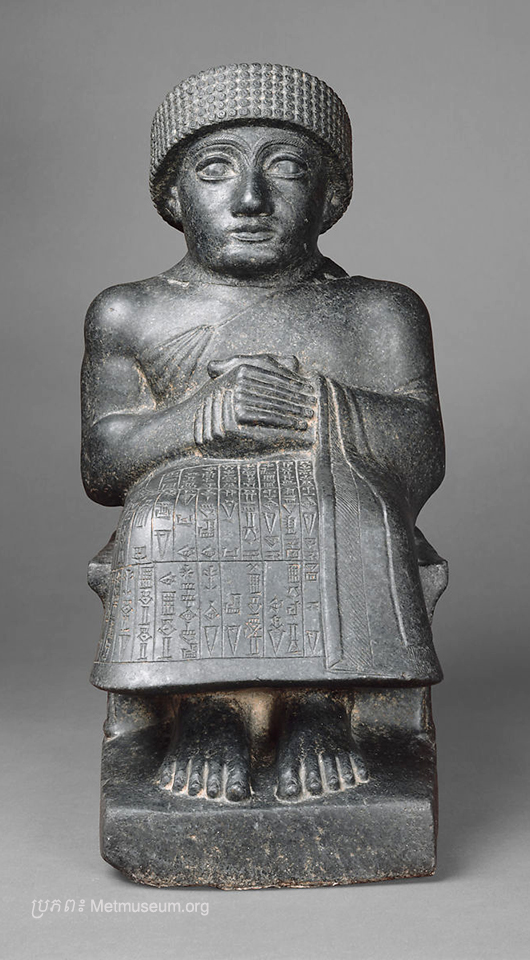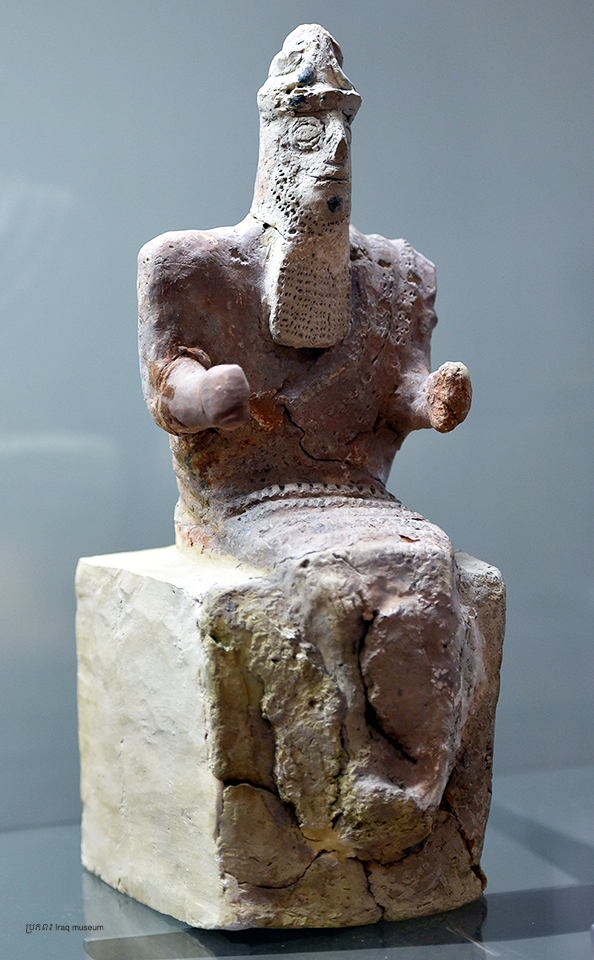ការលេចឡើងនូវជំនឿសាសនានៅក្នុងប្រវត្តិសាស្ត្រមនុស្ស គឺជាប្រធានបទមួយដែលមានការជជែកគ្នាយ៉ាងច្រើនក្នុងចំណោមអ្នកស្រាវជា្រវមួយចំនួនដូចជា ប្រវត្តិវិទូ, នរវិទូ និងបុរាណវិទូជាដើម។ យើងអាចដឹងអំពីសាសនា និងការគោរពរបស់មនុស្សសម័យបុរាណគឺតាមរយៈភស្តុតាងបុរាណវិទ្យា និងការគោរពប្រចាំថ្ងៃរបស់មនុស្សបច្ចុប្បន្ន ដែលភស្តុតាងបុរាណវិទ្យានោះរួមមាន ដូចជា ស្ថានីយបញ្ចុះសព , សិលាចារឹក, សំណង់ស្ថាបត្យកម្ម និងវត្ថុសិល្បៈផ្សេងៗ។
ភស្តុតាងដំបូងដែលបានបង្ហាញ អំពីការគោរពសាសនាក្នុងអរិយធម៌មេសូម៉ូតាមីនោះគឺការបង្ហាញតាមរយៈការកសាងប្រាសាទ ការឆ្លាក់រូបមនុស្ស មនុស្សមានក្បាលជាសត្វ និង សត្វ។ ការឆ្លាក់នោះនៅមានតាមជញ្ចាំង លើផ្ទាំងសិលាចារឹកដែលចារជាអក្សរ Cuneiform និងសសរនៅតាមប្រាសាទដែលបានបង្ហាញអំពីការជឿ និងការគោរពទៅលើអាទិទេព។ ជាមួយគ្នានោះដែរការកសាងប្រាសាទគឺកើតឡើងតាមរយៈទស្សនៈនៃសាសនា ដែលមនុស្សក្នុងអរិយធម៌នេះជឿលើអាទិទេពគ្រប់គ្រង និងការពារចក្រវ័ល។ រាល់ទីក្រុងនៃអរិយធម៌មេសូប៉ូតាមី សុទ្ធសឹងតែមានការកសាងប្រាសាទ Ziggurat ដើម្បីឧទ្ទិសដល់អាទិទេពផ្សេងៗដែលមានន័យថាទីក្រុងទាំងនោះ គឺបានភ្ជាប់ជានឹងអាទិទេពតាមរយៈZiggurat។ Ziggurat គឺជាប្រាសាទដែលមានរាងខឿនខ្ពស់ មានជណ្តើរនៅខាងមុខ និងនៅខាងលើមានប្រាសាទតូចមួយ។ ឧទាហរណ៍៖ ប្រាសាទដែលល្បីល្បាញមួយក្នុងអរិយធម៌នេះ គឺមានឈ្មោះ Ziggurat of Ur ឬ White Temple ដែលបច្ចុប្បន្នស្ថិតនៅក្នុងប្រទេស អ៊ីរ៉ាក់ ដែលសម្រាប់ឧទ្ទិសដល់អាទិទេពមួយដែលមានឈ្មោះថា Anu ( Sky god) ដែលស្ថិតក្នុងសម័យកាល Sumer។ នៅក្នុងសម័យកាល Babylon ប្រាសាទ Ziggurat គឺកសាងសម្រាប់ឧទ្ទិសដល់អាទិទេព Marduk ដែលជាអាទិទេពបង្កើតទឹក រុក្ខជាតិ និងជាទេពនៃសម្រាប់ យុតិធម៌ ដែលអាទិទេព Marduk នេះជាទេពដែលក្នុងសម័យ Babylon និយមគោរព។
សាសនានៅក្នុងអរិយធម៌មេសូប៉ូតាមីគឺមនុស្សជឿទៅលើអាទិទេពថា ដែលពួកគេជឿថា អាទិទេពជាអ្នកបង្កើតភពផែនដី រួមទាំងមនុស្ស សត្វ និងរុក្ខជាតិផងដែរ ហើយអាទិទេពទាំងនោះមានទំនាក់ទំនងជាមួយនឹងប្រព័ន្ធតារានិករ។ អាទិទេពទាំងអស់នោះប្រៀបបានដូចនឹង ជា Hero សម្រាប់ការពារ សង្រ្គោះ ព្យាបាល មនុស្សលោក ហើយស្តេចគឺជាអ្នកដែលមានទំនាក់ទំនងជាមួយនឹងអាទិទេព។ នៅពេលដែលមហាក្សត្រសុគតគេនាំគ្នាកសាងជារូបសំណាកស្តេច ដែលប្រដូចនឹងអាទិទេព សម្រាប់ការពារប្រជាជនពីសភាវៈអាក្រក់ផ្សេងៗ។ អាទិទេពដែលមានអំណាច និងសំខាន់ៗជាងគេនៅក្នុងអរិយធម៌មេសូមប៉ូតាមី ហៅថា អាទិទេពទាំង ប្រាំពីរ ដែលមានដូចជា Enlil ជាទេពគ្រប់គ្រង ទឹកដី ភ្លើង ខ្យល់ និងជាទេពធំជាងគេ, Anu ទេពគ្រប់គ្រងឋានសួគ៍, Anunnaki ឬ Ea ជាទេពបង្កើតទឹក និងជាទេពដែលមានចំណេះដឹងផ្នែកមន្តអាគម, Ninhursag ជាទេពស្រី និងទេពនៃការផ្តល់កំណើត, Nanna អាទិទេពតំណាងឱ្យព្រះចន្ទ, Utu អាទិទេពតំណាងឱ្យព្រះអាទិត្យ យុតិធម៌ និង Inanna ជាអាទិទេពនៃសេចក្តីស្រលាញ់ នយោបាយ និងសង្រ្គាម។ សាសនា គឺជាផ្នែកមួយនៃការីកចម្រើននៃអរិយធម៌ ជាពិសេស សាសនា បានផ្សាភ្ជាប់ជាមួយនឹងសង្គមមនុស្សជាតិ ហើយអាទិទេពត្រូវបានគេចាត់ទុកថាជាអ្នកគ្រប់គ្រងកំពូលនៃច្បាប់គ្រប់គ្រង អាកាសធាតុ និងការបង្កកំណើតលើផែនដី។
—————————
Religion in Mesopotamian Civilization
The emergence of religious beliefs in human history has been the subject of much debate among historians, anthropologists, and archaeologists, etc. We can know about the religion and worship of ancient people through archeological evidence and the daily worship of people today, which includes burial sites, inscriptions, architectural structures, and artifacts.
The earliest evidence of religious observance in the Mesomotamian civilization is indicated through temples, human statues, human-headed animals, and animals. That carvings are still on the walls, on the part of the inscription which wrote as Cuneiform and wrote on the pillars temples showed the belief in and worship of the deity. In addition, the building of the temple took place through the concept of religion, in which people in this civilization believed in a deity ruling and protecting the universe. Every city of Mesopotamian civilization has built Ziggurat temples dedicated to various deities, which means that the cities are connected to the deities through Ziggurat. Ziggurat is the high terrace temple contained stairs In front and a small temple above. For example, One of the most famous temples in this civilization is the Ziggurat of Ur or White Temple, now in Iraq, dedicated to a deity named Anu (Sky god) in the Sumer period. In the Babylon period, the temple of Ziggurat was dedicated to the god Marduk, the god of water and plants, and the god of justice, whom Marduk worshiped in the Babylon period.
Religions in Mesopotamian civilization believed that deities were the creators of the planet, including humans, animals, and plants, and that they were associated with a system of constellations. These deities are like the hero for protecting, saving, and healing people, and the king is the one who has a relationship with the deities. When the king died, a statue of the king was erected to protect the people from evil spirits. The most powerful and important deities in the Mesopotamian civilization are called the seven deities, namely Enlil, the ruler of the land, fire, air, and supremacy; Anu is the deity ruler of heaven; Anunnaki or Ea is the water and god of magical knowledge; Ninhursag is a goddess of birth; Nanna represents the moon; Utu represents the sun and justice; and Inanna is the goddess of love, politics, and war. Religion is part of the progress of civilization, especially religion, associated with humanity society, and deities are considered supreme rulers of the laws, climate, and creating the earth.
អត្ថបដោយ៖ លោក អេង តុលា









